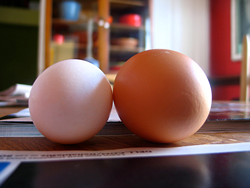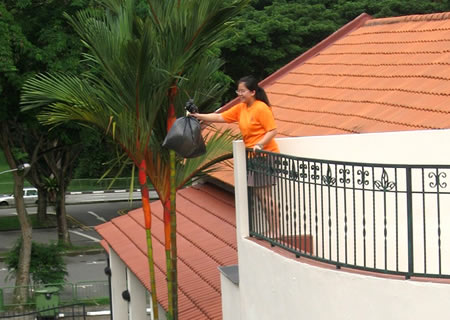Lesson: Egg Drop
 (Lesson Courtesy of Buddy2, an non-profit Indiana educational program, and Robert Feemster, Otterbein Elementary, Otterbein, IN.)
(Lesson Courtesy of Buddy2, an non-profit Indiana educational program, and Robert Feemster, Otterbein Elementary, Otterbein, IN.)
Level: Grades 5-12. Time Required: 1 to 2 class periods.
Egg Drop
Overview:
The egg drop is a fun and dramatic way to get students involved in engineering design. After a discussion of safety features, students experiment packaging an egg to produce a design that will allow it to fall from a considerable height without cracking.
Goals:
1. Students will choose appropriate packaging materials to fit an egg into a package measuring less than six inches on any side.
2. Students will recognize differences in success rates of the packaging materials.
3. Students will understand how results can turn out differently when similar or identical materials are used.
4. Students will be able to relate packaging an egg to everyday activities (car safety, moving vans, bicycle helmets, etc.)
5. Students will create a pie graph comparing their results.
Indiana State Standards:
Grades 3-5
- Mathematics: Data Analysis
- Science: Nature of Science
- Science: Physical Setting
Grades 6-8
- Mathematics – Data Analysis
- Science – Nature of Science
- Science – Physical Setting
Materials:
Each student team will need:
- Box or container not larger than six inches on any side
- packaging materials
- a raw egg
PROCEDURE
Preparation:
Teachers should determine ahead of time the point from which the eggs will be dropped, whether from the roof of the school building, from a school window, or from another height. Try to select a point at least two stories high. You may need to enlist another adult to drop the packages while the students watch from below and record the outcomes.
1. Lead the class in brainstorming about the safety features used for race car drivers, skaters, bicyclers, football players, etc. How are each protected from strong impacts? Which materials are used, and which seem to be the most protective? What factors need to be taken into consideration in designing and implement safety features?
2. Students then discuss ideas for materials that can be used to protect breakable objects when they are transported.
3. Inform students of their task: To design a container that can cushion the fall of an egg, with the stipulation that each container can be no more than six inches on each side.
4. Divide students into teams of 3-4 students and have each team brainstorm on the materials and design for their container. The team should bring their selected materials to class the next day. You may encourage them to test their packages at home before returning to school.
5. The drop: Before each package is dropped from the height to the sidewalk, the team should explain to the class their packaging process and concept while the other teams record this information.
6. After each egg is dropped, the package should be opened to check the condition of the egg. Teachers may wish to supply a judging criteria, such as “undamaged,” “slightly damaged,” “badly crushed.”
7. Students keep a tally of the number of eggs that survived versus those that broke.
8. Back in the classroom, have the class discuss the effectiveness of the various packaging materials. Which were the most effective, and why? Beyond the materials, which features of the packaging helped cushion the fall? Which packages were the most creative? If time permits, teams could revise their original designs for better performance, and the egg drop can be repeated.
9. The students create a computer pie graph using Microsoft Excel or another simple graphing program to illustrate the results of the Egg Drop.

Assessment:
Journal writing: students explain the outcome of their egg drop, and the success and failure of their design, as well exploring ways in which they might improve upon their design. They assess the design of the other teams, evaluating best and worst choices and suggestions to improve the packaging of those that broke.
The students will also make a pie graph using Excel to chart the results of the entire class.
Extensions:
Students can further practice their packaging abilities by sending breakable objects through the mail or by UPS; see an example in our “Pringles Challenge” activity.
“Eggs” image: http://www.flickr.com/photos/jonnyhunter/ / CC BY 2.0
Filed under: Grades 6-8, Grades 9-12, Lesson Plans
Tags: Engineering Design, Grades 5-12, Lesson Plan, Packaging Engineering, Physical Science, Physics, Safety engineering








